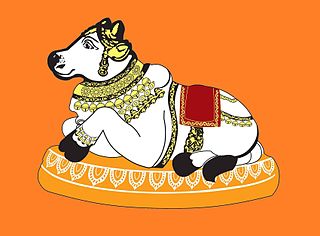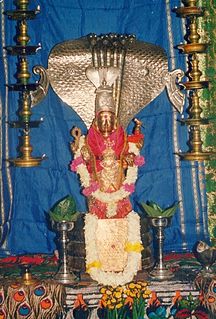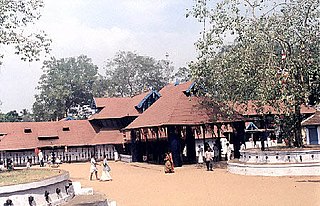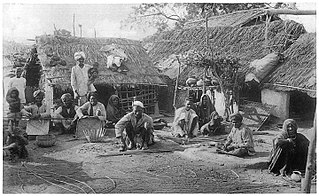
Māri, also known as Mariamman and Mariaai, both meaning "Mother Mari", spelt also Maariamma, or simply Amman or Aatha is a Hindu goddess of rain especially popular in Tamil Nadu and surrounding regions. She is the main mother goddess predominant in the rural areas of Tamil Nadu and Thirucherai. Māri is closely associated with the Hindu goddesses Parvati and Durga as well as with her northern counterpart Shitala devi. The goddess Mariamman is considered by many to be the incarnation of Goddess Kali. It is said that when Kali went to southern India as Mariamman, Bhairava followed her as Madurai Veeran. Her festivals are held during the late summer/early autumn season of "Aadi". Throughout the Tamil Nadu and deccan region, grand festival known as "Aadi Thiruvizha" are taken for Maariamman. Her worship mainly focuses on bringing rains and curing diseases like cholera, smallpox, and chicken pox.

Hinduism has a long tradition and which is the oldest religion in Sri Lanka. More than 2000 years civilization have proved so far from Hindu temples in Sri Lanka. Hindus currently make up 12.60% of the Sri Lankan population, and are almost exclusively Tamils apart from small immigrant communities from India and Pakistan such as the Sindhis, Telugus and Malayalees. In the 1915 census they made up almost 25% of the population, which included the indentured labourers the British had brought. Due to emigration, today they are still a sizeable minority. Hinduism is dominant in the North and Eastern provinces, where there are predominantly Tamil people. Hinduism is also practised in the central regions as well as in the capital, Colombo. According to the government census of 2011, there are 2,554,606 Hindus in Sri Lanka constituting 12.6% of the country's population. During the Sri Lankan Civil War, many Tamils fled to other countries. There are Hindu temples abroad which were built by the Sri Lankan Tamil diaspora to maintain their religion, tradition and culture.

Bhadrakālī is a Hindu goddess popular in Southern India. She is one of the fierce forms of the Great Goddess Adi Parashakthi or Durga (Devi) mentioned in the Devi Mahatmyam. Bhadrakali is the popular form of Devi Mahamaya worshipped in Kerala as Sri Bhadrakali, Mahakali, Chamunda and Kariam Kali Murti. In Kerala she is seen as the auspicious and fortunate form of Mahakali who protects the good.

Sri Lankan Tamils or Ceylon Tamils, also known as Eelam Tamils in Tamil, are members of the Tamil ethnic group native to the South Asian island state of Sri Lanka. According to anthropological and archaeological evidence, Sri Lankan Tamils have a very long history in Sri Lanka and have lived on the island since at least around the 2nd century BCE. Most modern Sri Lankan Tamils claim descent from residents of Jaffna Kingdom, a former kingdom in the north of the island and Vannimai chieftaincies from the east. They constitute a majority in the Northern Province, live in significant numbers in the Eastern Province and are in the minority throughout the rest of the country. 70% of Sri Lankan Tamils in Sri Lanka live in the Northern and Eastern provinces.
Mukkuvar is a caste found in the coastal regions of Sri Lanka and the Indian states of Tamil Nadu and Kerala.
Negombo Tamils or Puttalam Tamils are the native Sri Lankan Tamils who live in the western Gampaha and Puttalam districts of Sri Lanka. They are distinguished from other Tamils from the island nation by their unique dialects, one of which is known as Negombo Tamil dialect. Other sub categories of native Tamils of Sri Lanka are Jaffna Tamils or Northern Tamils and Batticalao Tamils or Eastern Tamils from the traditional Tamil dominant North and East of the Island nation. Negombo is a principal coastal city in the Gampaha District and Puttalam is also the principal city within the neighbouring Puttalam District.

Draupati Amman is a goddess from the Hindu epic Mahabharata, namely Draupadi, primarily worshipped by the Tamil people of India, Sri Lanka and other countries. Draupati was the wife of the five Pandava brothers in the Mahābhārata epic.She is also greatly believed to be the incarnation of hindu goddess Mariamman

Nainativu, is a small but notable island off the coast of Jaffna Peninsula in the Northern Province, Sri Lanka. The name of the island alludes to the folklore inhabitants, the Naga people. It is home to the Hindu shrine of Nagapooshani Amman Temple; one of the prominent 64 Shakti Peethas, and the Buddhist shrine Nagadeepa Purana Viharaya.

The Naga people were believed to be an ancient tribe who once inhabited Sri Lanka. There are references to them in several ancient text such as Mahavamsa, Manimekalai and also in other Sanskrit and Pali literature. They are generally being represented as a class of superhumans taking the form of serpents who inhabit a subterranean world. Texts such as Manimekalai represent them as persons in human form.

Sree Kurumba Bhagavati Temple is a Hindu temple at Kodungallur, Thrissur District, Kerala state, India. It is dedicated to the goddess Bhadrakali, a form of Maha Kali or Parashakthi worshipped in Kerala. The goddess is known also by the names "Sri Kurumba"" .This temple is the head of 64 Bhadrakali temples in Kerala especially Malabar. The goddess of the temple represents the goddess in her fierce ('ugra') form, facing North, featuring eight hands with various attributes. One is holding the head of the demon king Daruka, another a sickle-shaped sword, next an anklet, another a bell, among others. Routine worship at the temple every day at 03:00 and ends at 21:00 local time.

Thambiluvil Kannaki Amman Kovil is one of the most significant Hindu temples in the Ampara District of Eastern Province, Sri Lanka. It is situated about 70 km south of Batticaloa town and 11 km south to Akkaraipattu. This is considered as the one of the ancient temples of Mattakkalappu Desam made for Kannaki Amman, the heroine of the great Tamil epic Silappatikaram.
Hinduism in Tamil Nadu dates back to 5th century BC finding literary mention in Sangam literature. The total number of Tamil Hindus as per 2011 Indian census is 63,188,168 which forms 87.58% of the total popualation of Tamil Nadu. Hinduism is the largest religion of Tamil Nadu.

Nainativu Nagapooshani Amman Temple is an ancient and historic Hindu temple located amidst the Palk Strait on the island of Nainativu, Sri Lanka. It is dedicated to Parvati who is known as Nagapooshani or Bhuvaneswari and her consort, Shiva who is named here as Nayinaar. The temple's fame is accredited to Adi Shankaracharya, a 9th-century Hindu philosopher, for identifying it as one of the prominent 64 Shakti Peethams in Shakti Peetha Stotram and its mention in the Brahmanda Purana. The temple complex houses four gopurams ranging from 20–25 feet in height, to the tallest being the eastern Raja Raja Gopuram soaring at 108 feet high. The temple is a significant symbol for the Tamil people, and has been mentioned since antiquity in Tamil literature, such as Manimekalai and Kundalakesi. The present structure was built during 1720 to 1790 after the ancient structure was destroyed by the Portuguese in 1620. The temple attracts around 1000 visitors a day, and approximately 5000 visitors during festivals. The annual 16-day Mahostavam (Thiruvizha) festival celebrated during the Tamil month of Aani (June/July) - attracts over 100,000 pilgrims. There is an estimated 10,000 sculptures in this newly renovated temple.

Kannaki Amman is the deified form of Kannagi, the heroine of the great Tamil epic Silapathikaram, worshipped mainly in Sri Lanka and Kerala. As the goddess of chastity, rain and fertilization, she is well praised by the Malayalis and the two main ethnicities of Sri Lanka, the Sri Lankan Tamil Saivites and also by the Sinhalese Buddhists as Pattini Deviyo.
Sri Lankan Paraiyar is a Tamil caste found in northern and eastern Sri Lanka. They are traditional parai-drummers who additionally were involved in weaving and scavenging.














